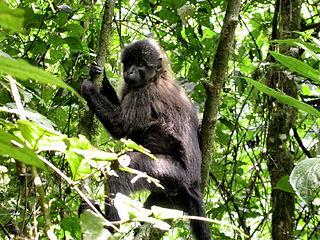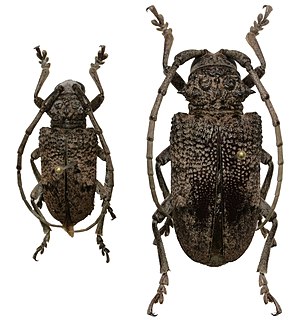Related Research Articles

The crested mangabeys are West African Old World monkeys belonging to the genus Lophocebus. They tend to have dark skin, eyelids that match their facial skin, and crests of hair on their heads. Another genus of mangabeys, Cercocebus, was once thought to be very closely related, so much so that all the species were placed in one genus. However, Lophocebus species are now understood to be more closely related to the baboons in genus Papio, while the Cercocebus species are more closely related to the mandrill. In 2006, the highland mangabey was moved from Lophocebus to a new genus, Rungwecebus.

The Uganda mangabey is a species of Old World monkey found only in Uganda and in the Minziro Forest Reserve, just over the border in Tanzania. This crested mangabey was previously thought to just be a population of the grey-cheeked mangabey. Colin Groves upgraded the Ugandan population to the new species L. ugandae on 16 February 2007. This species is significantly smaller than the grey-cheeked mangabey, with a shorter skull and smaller face. 2008 was the most recent year in which the International Union for Conservation of Nature assessed the conservation status of L. albigena, describing it as being of least concern, and the status of L. ugandae has not been assessed separately.
Johnston's mangabey is a species of crested mangabey in the family Cercopithecidae. It had been considered a subspecies of the gray-cheeked mangabey, but in 2007 was given the status of species by Colin Groves, with Osman Hill's mangabey and the Uganda mangabey.
Temnora griseata is a moth of the family Sphingidae. It is known from forests from Nigeria to southern Congo, southern Tanzania and Malawi.
Epitolina catori, the red-patch epitolina, is a butterfly in the family Lycaenidae. It is found in Sierra Leone, Ivory Coast, Ghana, Togo, Nigeria, Cameroon, the Central African Republic, the Democratic Republic of the Congo, Uganda and Tanzania. Its habitat consists of forests.
Hewitsonia ugandae is a butterfly in the family Lycaenidae. It is found in Cameroon, Gabon, the Democratic Republic of the Congo and western Uganda.
Ornipholidotos ugandae is a butterfly in the family Lycaenidae. It is found in Cameroon, Equatorial Guinea, the Republic of the Congo, Gabon, Angola, the Central African Republic, the Democratic Republic of the Congo, Uganda and Tanzania. The habitat consists of forests.

Argyrocheila undifera, the fairy white, is a butterfly in the family Lycaenidae. It is found in Sierra Leone, Ivory Coast, Ghana, Nigeria, Cameroon, Gabon, the Republic of the Congo, the Central African Republic, the Democratic Republic of the Congo, Uganda and Tanzania. Its habitat consists of primary forests.
Paralpenus ugandae is a moth of the family Erebidae. It was described by George Hampson in 1916. It is found in Eritrea, Kenya and Uganda.
Parabiobessa ugandae is a species of beetle in the family Cerambycidae, and the only species in the genus Parabiobessa. It was described by Breuning in 1936.
Paschiodes ugandae is a moth in the family Crambidae. It was described by Koen V. N. Maes in 2005. It is found in Uganda.

Pterolophia is a genus of longhorn beetles of the subfamily Lamiinae, containing the following species:
Crossotus ugandae is a species of beetle in the family Cerambycidae. It was described by Breuning in 1936. It is known from Kenya and Somalia.
Dichostates ugandae is a species of beetle in the family Cerambycidae. It was described by Breuning in 1935. It is known from the Democratic Republic of the Congo and Uganda.
Oeceoclades ugandae is a terrestrial orchid species in the genus Oeceoclades that is native to parts of tropical Africa, including west tropical Africa, west-central tropical Africa, northeast tropical Africa (Ethiopia), and east tropical Africa. It was first described by the British botanist Robert Allen Rolfe in 1913 as Eulophia ugandae and later transferred to the genus Oeceoclades in 1976 when Leslie Andrew Garay and Peter Taylor resurrected and revised that genus. The English botanist V.S. Summerhayes treated this species as a synonym of O. latifolia, but Garay and Taylor noted that while the two species share a superficial resemblance in the appearance of the labellum, they are distinct in vegetative morphology. The labellum of O. ugandae also has two swellings or protuberances between the lateral and midlobes, a feature that O. latifolia lacks.

The Fig-tree Borer Longhorn Beetle, or Fig Tree Borer, is a species of beetle in the family Cerambycidae. It was described by Johan Christian Fabricius in 1792, originally under the genus Lamia. It has a wide distribution throughout Africa. It feeds on Pyrus communis, Ficus carica, Salix babylonica, Cupressus sempervirens, and Vitis vinifera.
Pterolophia instabilis is a species of beetle in the family Cerambycidae. It was described by Per Olof Christopher Aurivillius in 1922. It is known from Seychelles.
Pterolophia guineensis is a species of beetle in the family Cerambycidae. It was described by James Thomson in 1864, originally under the genus Alyattes.
References
- ↑ BioLib.cz - Pterolophia ugandae. Retrieved on 8 September 2014.